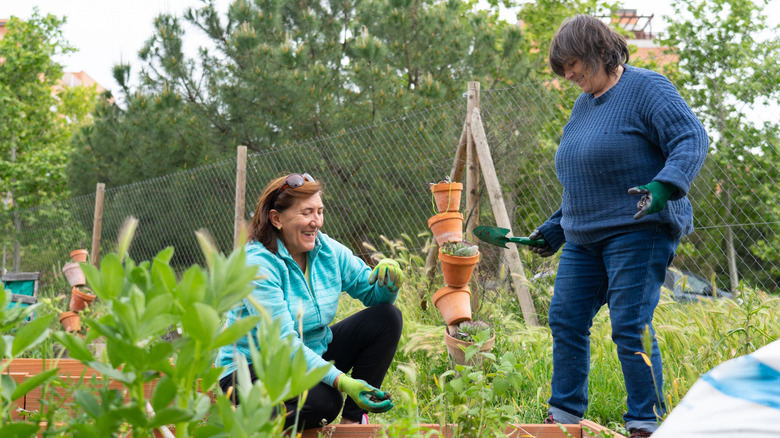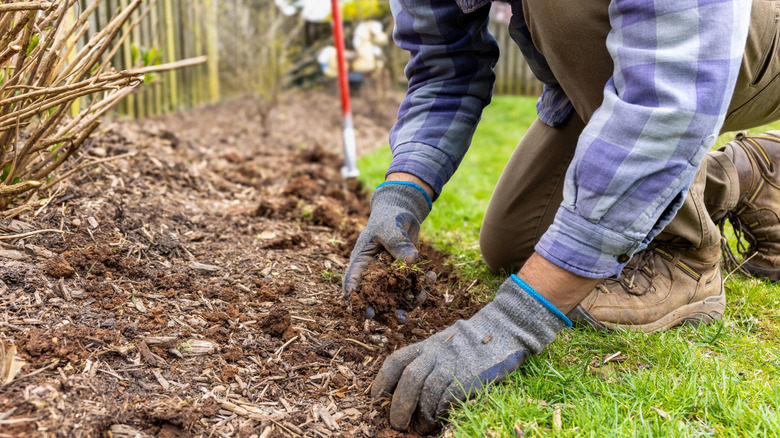What's The Difference Between Regenerative Gardening And Permaculture Gardening?
Once you open the gate to making your garden more sustainable, it's not just tips and tricks you'll come across, but also terms that refer to different philosophies and practices. When words like 'permaculture' and 'restorative' come up in a video or at a meeting of like-minded gardeners, their nuances are not always explained. It's good to know what makes restorative and permaculture gardening different from each other so you can figure out what you most align with and what's best for your garden.
Permaculture and restorative gardening practices often work hand in hand, but there are important differences in their focus and scope. Permaculture is a design system based on ethics that places gardening or farming in the context of adapting to a changing world, while regenerative gardening is more specific to time-tested agricultural methods that naturally improve the soil. To tell the difference between regenerative gardening and permaculture gardening, ask yourself whether the advice is more about rehabilitating the land or being a climate-aware gardener; it's likely that the former is regenerative and the latter is permaculture.
Regenerative gardening makes soil health a priority
Regenerative gardeners follow restorative or regenerative agricultural practices in their gardens or community plots. This discipline is focused on restoring the ecosystem by growing and producing food sustainably. It is based on the traditional ways indigenous people tend to the land. Regenerative gardening is all about helping the soil recover from damage that started when agriculture was industrialized. Industrialization brought with it the use of pesticides, which can harm pollinator-friendly plants, and the trend of growing crops in monocultures rather than varying them. Monocultures sap nutrients from the soil and make it more likely to erode. Another bad aspect of conventional agriculture is tilling, which makes soil erosion worse.
Putting restorative agriculture into practice in your garden involves techniques that can help reverse this damage as well as benefit wildlife and the environment. Restorative gardeners work to fight climate change and help plants at the same time through gardening methods that store carbon. This is done through covering the soil with mulch or protective plants, rotating their crops, composting, and eliminating or reducing tilling. Instead of dedicating patches to the same vegetable season after season, being a restorative gardener means rotating your vegetable garden, or growing plants that offer benefits to each other in the same space, known as interplanting.
Permaculture gardening considers the big picture
Permaculture takes a broader approach; imagine the lens zooming out from a focus on food growth and production to the way human activity affects not just the soil but the whole ecosystem. The idea is to create landscapes that mirror natural patterns while prioritizing the re-use of materials and reducing waste in gardening. Since those who practice permaculture are interested in adapting the human environment and behavior to mitigate the loss of resources, creating a climate-resistant garden is a project they would relish.
A highlight of permaculture is its goal of creating garden systems that sustain themselves; for example, gardeners may attract beneficial insects to take care of pests rather than relying on chemical pesticides. Instead of using a hose with fresh water, permaculture gardeners sometimes collect rainwater in barrels. And unlike regenerative gardening, which involves planting different crops as seasons change, permaculture asks for minimal replanting and encourages gardening with perennial plants. This could mean growing kale and radicchio, vegetables that naturally re-seed. Instead of a solution that involves planting, like using cover crops to keep nutrients in the soil, those who practice permaculture might make waste work for the garden by reusing kitchen scraps as a natural fertilizer. Companion planting is also encouraged, so the plants can benefit each other without the gardener having to intervene.


